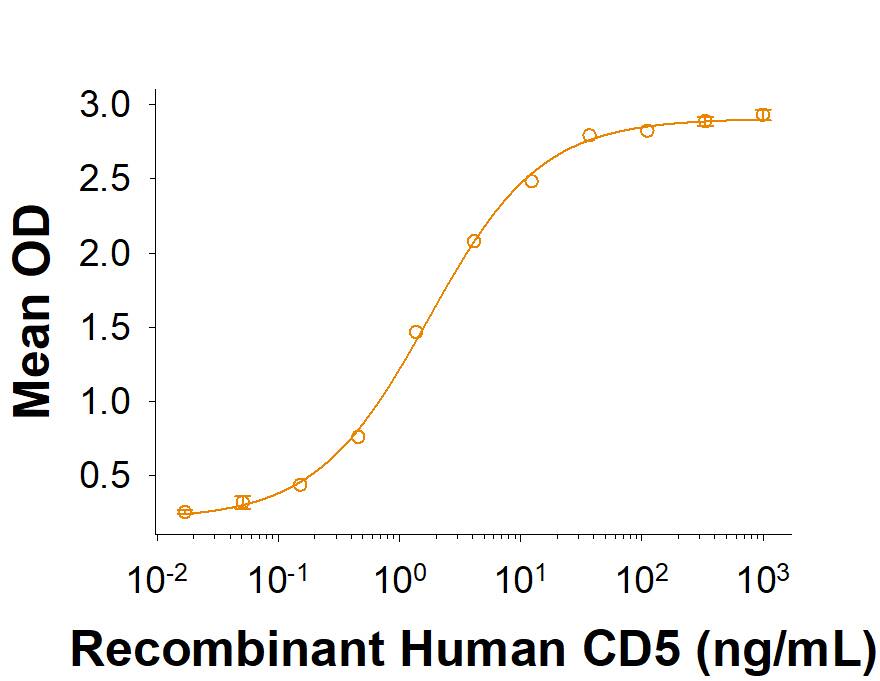Recombinant Human CD5 Fc Chimera Protein, CF
R&D Systems, part of Bio-Techne | Catalog # 11389-CD

Key Product Details
Source
HEK293
Accession #
Structure / Form
Disulfide-linked homodimer
Conjugate
Unconjugated
Applications
Bioactivity
Product Specifications
Source
Human embryonic kidney cell, HEK293-derived human CD5 protein
| Human CD5 (Arg25-Asn371) Accession # P06127.2 |
IEGRMD | Human IgG1 (Pro100-Lys330) |
| N-terminus | C-terminus |
Purity
>95%, by SDS-PAGE visualized with Silver Staining and quantitative densitometry by Coomassie® Blue Staining.
Endotoxin Level
<0.10 EU per 1 μg of the protein by the LAL method.
N-terminal Sequence Analysis
Arg25
Predicted Molecular Mass
65 kDa
SDS-PAGE
72-83 kDa, under reducing conditions.
Activity
Measured by its binding ability in a functional ELISA.
Recombinant Human CD5 Fc Chimera (Catalog # 11389-CD) binds to Human CD5 Antibody (Catalog # MAB16361) with a ED50 of 0.800-8.00 ng/mL.
Recombinant Human CD5 Fc Chimera (Catalog # 11389-CD) binds to Human CD5 Antibody (Catalog # MAB16361) with a ED50 of 0.800-8.00 ng/mL.
Scientific Data Images for Recombinant Human CD5 Fc Chimera Protein, CF
Recombinant Human CD5 Fc Chimera Protein Binding Activity.
Measured by its binding ability in a functional ELISA. Recombinant Human CD5 Fc Chimera Protein (Catalog # 11389-CD) binds to Human CD5 Antibody (MAB16361) with a ED50 of 0.800-8.00 ng/mL.Recombinant Human CD5 Fc Chimera Protein SDS-PAGE.
2 μg/lane of Recombinant Human CD5 Fc Chimera Protein (Catalog # 11389-CD) was resolved with SDS-PAGE under reducing (R) and non-reducing (NR) conditions and visualized by Coomassie® Blue staining, showing bands at 72-83 kDa and 140-170 kDa, respectively.Formulation, Preparation and Storage
11389-CD
| Formulation | Lyophilized from a 0.2 μm filtered solution in PBS with Trehalose. |
| Reconstitution | Reconstitute at 500 μg/mL in PBS. |
| Shipping | The product is shipped at ambient temperature. Upon receipt, store it immediately at the temperature recommended below. |
| Stability & Storage | Use a manual defrost freezer and avoid repeated freeze-thaw cycles.
|
Background: CD5
References
- Soldevila, G. et al. (2011) Curr. Opin. Immunol. 23:310.
- Jones, N.H. et al. (1986) Nature 323:346.
- Calvo, J. et al. (1999) Tissue Antigens 54:128.
- Brown, M.H. and E. Lacey (2010) J. Immunol. 185:6068.
- Van de Velde, H. et al. (1991) Nature 351:662.
- Vera, J. et al. (2009) Proc. Natl. Acad. Sci. 106:1506.
- Azzam, H.S. et al. (1998) J. Exp. Med. 188:2301.
- Hawiger, D. et al. (2004) Immunity 20:695.
- Tarakhovsky, A. et al. (1995) Science 269:535.
- Friedlein, G. et al. (2007) J. Immunol. 178:6821.
- Ordonez-Rueda, D. et al. (2009) Eur. J. Immunol. 39:2233.
- de Wit, J. et al. (2011) Blood 118:6107.
- Bikah, G. et al. (1996) Science 274:1906.
- Hippen, K.L. et al. (2000) J. Exp. Med. 191:883.
- Yanaba, K. et al. (2008) Immunity 28:639.
- Gary-Gouy, H. et al. (2002) Blood 100:4537.
- Renaudineau, Y. et al. (2005) Blood 106:2781.
- Sarhan, M.A. et al. (2012) J. Virol. Epub.
Alternate Names
CD5
Gene Symbol
CD5
UniProt
Additional CD5 Products
Product Documents for Recombinant Human CD5 Fc Chimera Protein, CF
Product Specific Notices for Recombinant Human CD5 Fc Chimera Protein, CF
For research use only
